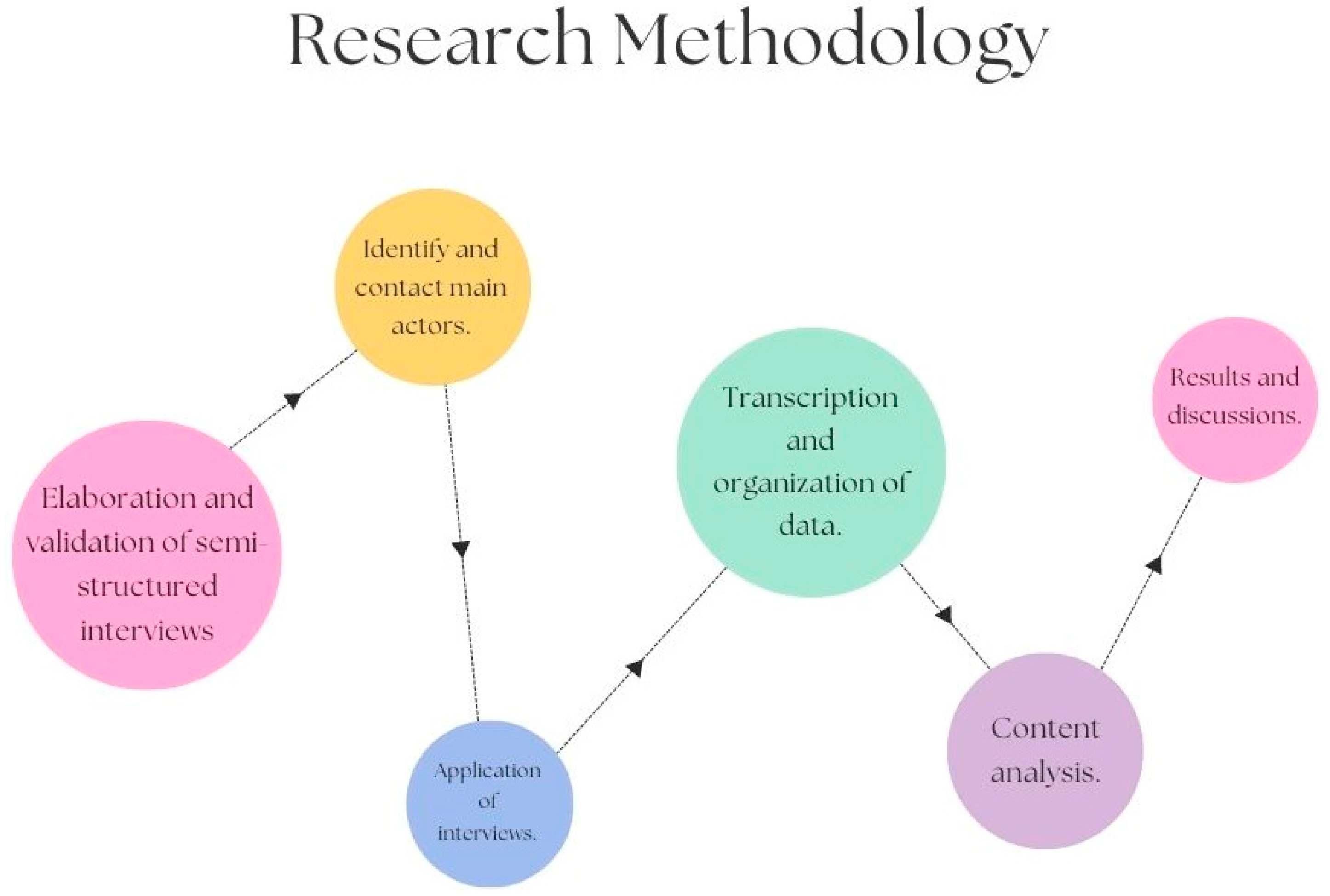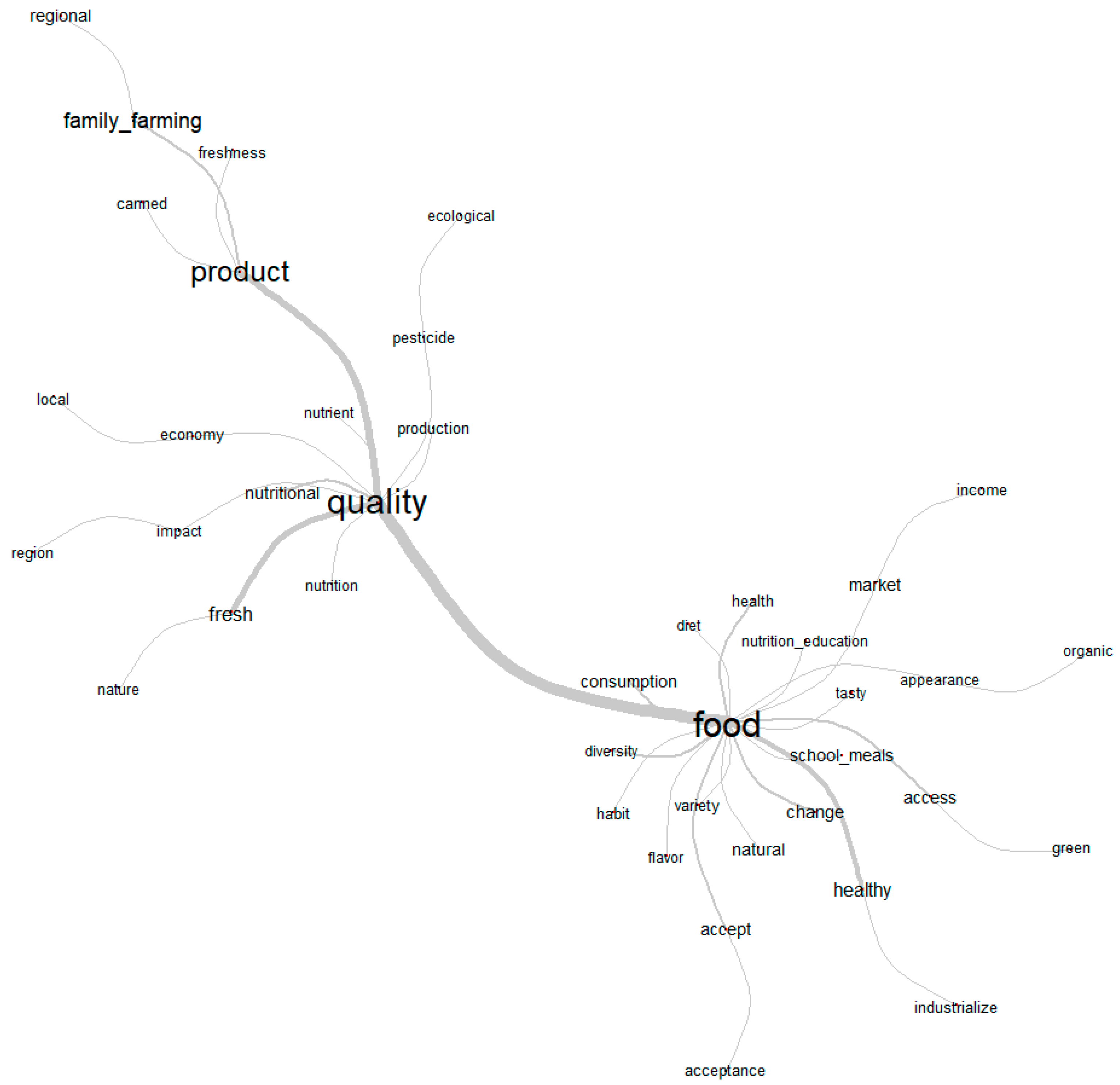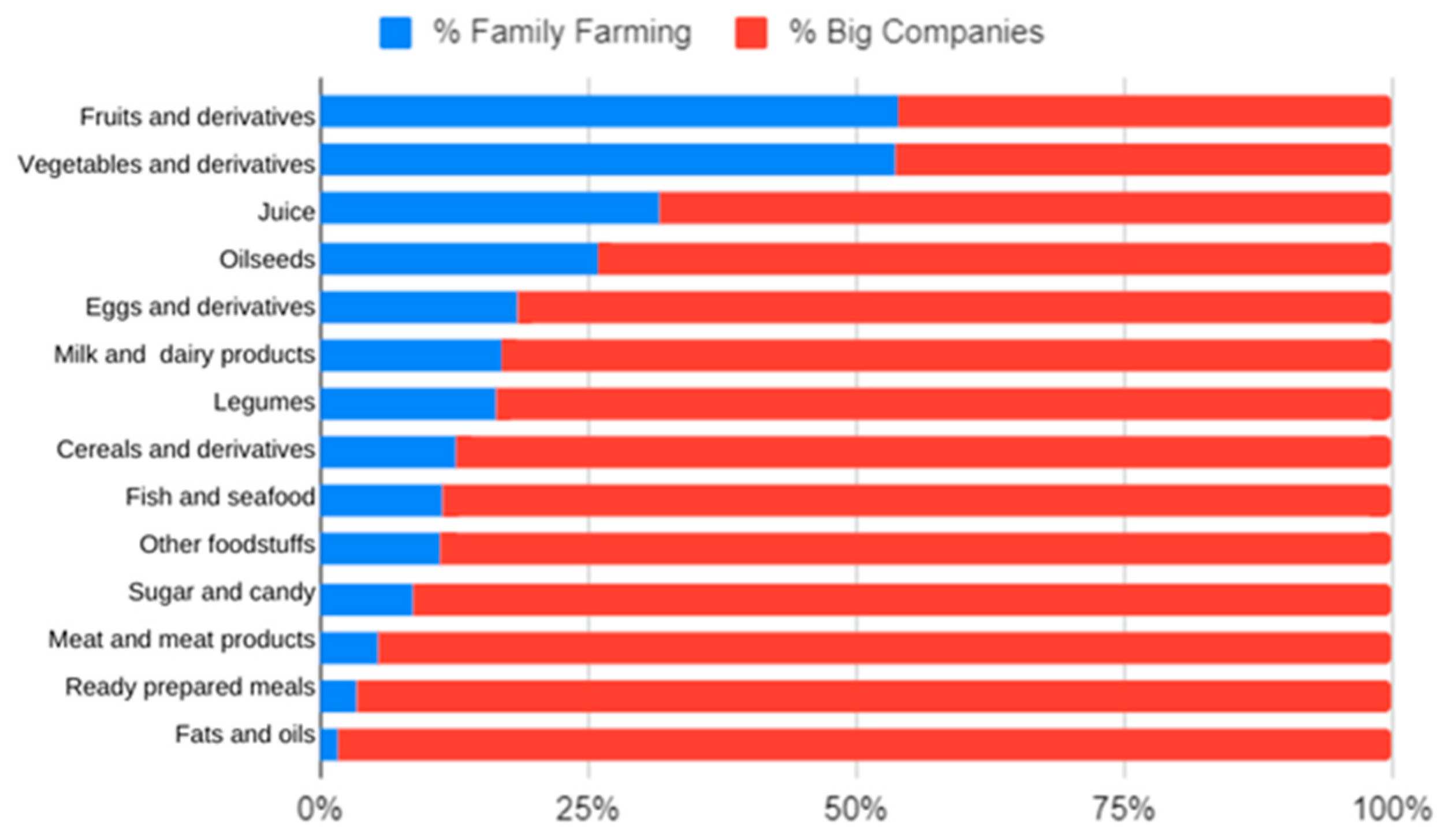Case Study of the School Feeding Program in Distrito Federal, Brazil: Building Quality in Short Food Supply Chains
Abstract
:1. Introduction
2. Materials and Methods
2.1. The Actors
- Managers: individuals who hold management positions within the Executing Entity (SEEDF) or FNDE;
- School managers: principals, vice-principals, and administrative coordinators of public schools who are responsible for managing the food-related processes in schools;
- Cafeteria cooks: professionals responsible for receiving, handling, and preparing school meals. They are also responsible for serving the students and for organizing and cleaning the school kitchens;
- Nutritionists: health professional responsible for food security and for the preparation of menus under the Program;
- CAE members: members of the current management of the Distrito Federal School Food Council; and
- Farmers: representatives of cooperatives and associations or individual producers who provide food to the Program in Distrito Federal and are considered family farmers.
2.2. Data
2.3. The School Feeding Program in Distrito Federal, Brazil
3. Results
Yes, I trust it. I do not know this issue of pesticides, the quantity…, but they are good foods.(CAFETERIA COOK 4)
Apparently, it does not cause any suspicion, because of the possibility of returning it if you don’t find the expected quality, right?(SCHOOL MANAGER 4)
They are of better quality, they are fresher foods because they come from the region, so the transport is faster, they are fresher, healthier foods, with a low amount of pesticides, so they are much better.(SCHOOL MANAGER 2)
It has happened, for example, that some type of food arrived that was not very good and we had to return it, this is an easy procedure to do. We contact the SEEDF, process the return, they collect it and exchange it. It’s not stressful at all.(SCHOOL MANAGER 1)
The only thing I think is that, because of the inferior quality, they often are not products from family farms. I suspect that they come from a big fair, from a larger producer, or from someone who buys and transfers them as a family-farm product, I don’t know how far SEEDF’s control of this reaches.(SCHOOL MANAGER 6)
And these cooperatives and associations are spread throughout the DF and the surrounding area, so for geographic reasons, it is also easier for the farmer to plant, harvest, and deliver to the school. If the farmer is from Planaltina-DF he delivers it to the Planaltina-DF school, so it’s very fast, you don’t lose produce. With the outsourced company we still have a contract with to supply other items is different, because you pay them and they buy from another producer and then they deliver, there is more intermediation, the produce no longer has the best quality.(MANAGER 1)
In general, that’s what it is, better produce condition, better produce quality, the strengthening of policies, and like I said, families can participate more, have a guaranteed source of income, not necessarily having to leave the countryside and go to the city, it also helps to fight the rural exodus, right, so by making this happen we can act on several fronts.(MANAGER 1)
The products are healthier. Fruits and vegetables are much healthier than processed foods because they have no pesticides.(CAFETERIA COOK 5)
Our menus in a way depend on us having family farming so that we have this improvement in results, fewer cookies, less canned items, less concentrate, more fruits, more vegetables, more fresh meat, more animal protein.(MANAGER 1)
The way we produce is ecological cultivation, and I can guarantee, without fear, that at least eighty percent of what is supplied does not have chemical pesticides, but a mineral pesticide. So eighty percent of the products are produced ecologically, the majority fertilized with chicken litter.(FARMER 2)
Quality is essential, especially at the Cooperative. How do we work it out? Everything is processed on Sundays, right. So the products that last longer, say sweet potato, pumpkin, they can even be harvested on Saturday afternoon. Now, the most perishable products are cabbage, chives, parsley, this is all harvested on Sunday afternoons and they arrive early in the evening at the Cooperative. And early in the evening, they are sorted, separated by school, everything is weighed and placed in the trucks. We finish around midnight or two in the morning, so the trucks are loaded by five o’clock in the morning, ready to make the deliveries. So the freshness is much greater.(FARMER 1)
- Prioritizing the purchase of fruits and vegetables: the PNAE policy and the legislation itself limit the purchase of products rich in sugar and sodium, and prioritize the purchase of fruits and vegetables, considering the nutritional character of these products. Thus, products such as jams, dulce de leche, and other products rich in sugar face serious obstacles, hampered by the food policy itself, focused on healthy nutrition.
- Legislation as an obstacle: many farmers find it difficult to adapt to health and sanitary legislation and product certification, so many of them operate informally, which ultimately makes it unfeasible for the institutional market to buy from them [44].
- Agricultural vocation: According to CODEPLAN [16], rural, family-based establishments in the DF are focused on the production of large crops, fruit, and horticulture.
4. Discussion
With an SFSC it is not the number of times a product is handled or the distance over which it is ultimately transported which is necessarily critical, but the fact that the product reaches the consumer embedded with information.(Marsden et al., 2000, p. 425)
- Face-to-face: In this type of chain, the consumer purchases a product directly from the producer/processor in a face-to-face dynamic. Authenticity and trust are measured by personal interaction.
- Spatial proximity: Products are produced and marketed in the specific (local) region of production, and consumers are informed about the “local” nature of the product at the point of sale.
- Spatially extended: In this type of chain, value-laden, meaningful information about the production and who produced the food is translated to consumers who are outside the region of production, and who may not have any personal experience with that region.
5. Conclusions
Author Contributions
Funding
Institutional Review Board Statement
Informed Consent Statement
Data Availability Statement
Conflicts of Interest
References
- Renting, H.; Marsden, T.K.; Banks, J. Understanding alternative food networks: Exploring the role of short food supply chains in rural development. Environ. Plan. A 2003, 35, 393–411. [Google Scholar] [CrossRef]
- Goodman, M.K.; Goodman, D. Place and Space in Alternative Food Networks: Connecting Production and Consumption; Environment Politics and Development Working Paper Series; Department of Geography, King’s College: London, UK, 2009; Volume 21. [Google Scholar]
- Wang, M.; Kumar, V.; Ruan, X.; Saad, M.; Garza-Reyes, J.A.; Kumar, A. Sustainability concerns on consumers’ attitude towards short food supply chains: An empirical investigation. Oper. Manag. Res. 2021, 1–17. [Google Scholar] [CrossRef]
- Anggraeni, E.W.; Handayati, Y.; Novani, S. Improving Local Food Systems through the Coordination of Agriculture Supply Chain Actors. Sustainability 2022, 14, 3281. [Google Scholar] [CrossRef]
- Marsden, T.; Banks, J.; Bristow, G. Food supply chain approaches: Exploring their role in rural development. Sociol. Rural. 2000, 40, 424–438. [Google Scholar] [CrossRef]
- Goodman, D. The quality ‘turn’ and alternative food practices: Reflections and agenda. J. Rural Stud. 2003, 1, 1–7. [Google Scholar] [CrossRef]
- Harvey, L.; Green, D. Defining quality. Assess. Eval. High. Educ. 1993, 18, 9–34. [Google Scholar] [CrossRef]
- Ilbery, B.; Kneafsey, M. Producer constructions of quality in regional speciality food production: A case study from south west England. J. Rural Stud. 2000, 16, 217–230. [Google Scholar] [CrossRef]
- Sonnino, R. Quality food, public procurement, and sustainable development: The school meal revolution in Rome. Environ. Plan. A Econ. Space 2009, 41, 425–440. [Google Scholar] [CrossRef]
- Stein, M.; Hunter, D.; Swensson, L.; Schneider, S.; Tartanac, F. Public Food Procurement: A Transformative Instrument for Sustainable Food Systems. Sustainability 2022, 14, 6766. [Google Scholar] [CrossRef]
- Peixinho, A.; Balaban, D.; Rimkus, L.; Schwartzman, F.; Galante, A.P. Alimentação escolar no Brasil e nos Estados Unidos. O Mundo Saúde 2011, 35, 128–136. [Google Scholar]
- Brasil. Law 11,497. 2009. Available online: http://www.planalto.gov.br/ccivil_03/_ato2007-2010/2009/lei/l11947.htm (accessed on 10 December 2019).
- Bardan, L. L’Analyse de Contenu, 70th ed.; Presses Universitaires de France: Lisbon, Portugal, 2006. [Google Scholar]
- de Souza, M.A.R.; Wall, M.L.; Lowen, I.M.V.; Peres, A.M. The use of IRAMUTEQ software for data analysis in qualitative research. Rev. Esc. Enferm. USP 2018, 52, e03353. [Google Scholar] [CrossRef]
- Camargo, B.V.; Justo, A.M. Tutorial Para Uso do Software de Análise Textual IRAMUTEQ. Universidade Federal de Santa Catarina [Internet]. 2018. Available online: http://www.iramuteq.org/documentation/fichiers/tutoriel-en-portugais (accessed on 25 April 2019).
- CODEPLAN, Distrito Federal Planning Company. Agricultura Familiar no Distrito Federal—Dimensões e Desafios. 2015. Available online: http://www.codeplan.df.gov.br/wp-content/uploads/2018/02/Agricultura-Familiar-no-DF-Dimens%C3%B5es-e-Desafios.pdf (accessed on 1 April 2019).
- IBGE—Brazilian Institute of Geography and Statistics. Brasil em Síntese, Distrito Federal. 2018. Available online: https://cidades.ibge.gov.br/brasil/df/panorama (accessed on 2 April 2019).
- Wittman, H.; Blesh, J. Food Sovereignty and Fome Zero: Connecting Public Food Procurement Programmes to Sustainable Rural Development in Brazil. J. Agrar. Change 2017, 17, 81–105. [Google Scholar] [CrossRef]
- GDF—Distrito Federal Government. Alimentação Escolar. 2019. Available online: http://df.gov.br/alimentacao-escolar (accessed on 29 December 2019).
- SEEDF—State Secretariat of Education of Distrito Federal. Manual da Alimentação Escolar no Distrito Federal. 2010. Available online: http://www.crn1.org.br/wp-content/uploads/2015/04/merenda.pdf?x53725 (accessed on 15 August 2019).
- FNDE—National Education Development Fund. Aquisição de Produtos da Agricultura Familiar Para a Alimentação Escolar, 2nd ed.; FNDE: Brasília, Brazil, 2016.
- Fornazier, A.; Belik, W. Produção e consumo local de alimentos: Novas abordagens e perspectivas para as políticas públicas. Segurança Aliment. Nutr. 2013, 20, 204–218. [Google Scholar] [CrossRef]
- Weatherell, C.; Tregear, A.; Allinson, J. In search of the concerned consumer: UK public perceptions of food, farming and buying local. J. Rural Stud. 2003, 19, 233–244. [Google Scholar] [CrossRef]
- Miškolci, S. Consumer Preferences Expressed via Shopping in Alternative Food Chains. Acta Univ. Agric. Silvic. Mendel. Brun. 2017, 65, 311–318. [Google Scholar] [CrossRef]
- Darolt, M.R.; Lamine, C.; Brandenburg, A.; Alencar, M.D.C.F.; Abreu, L.S. Redes alimentares alternativas e novas relações produção-consumo na França e no Brasil. Ambient. Soc. 2016, 19, 1–22. [Google Scholar] [CrossRef]
- Aguiar, L.D.C.; DelGrossi, M.E.; Thomé, K.M. Short food supply chain: Characteristics of a family farm. Ciênc. Rural 2018, 48, 1–8. [Google Scholar] [CrossRef]
- Souza, A.B.D.; Fornazier, A.; Delgrossi, M.E. Local food systems: Potential for new market connections for family farming. Ambient. Soc. 2020, 23, 1–20. [Google Scholar] [CrossRef]
- Franzoni, G.B.; Silva, T.N. Inovação Social e Tecnologia Social: O caso da Cadeia Curta de Agricultores Familiares e a Alimentação Escolar em Porto Alegre/RS. Desen. Questão 2016, 14, 353–386. [Google Scholar] [CrossRef]
- Izumi, B.T.; Wright, D.W.; Hamm, M.W. Farm to school programs: Exploring the role of regionally-based food distributors in alternative agrifood networks. Agric. Hum. Values 2010, 27, 335–350. [Google Scholar] [CrossRef]
- Morgan, K.; Sonnino, R. Empowering consumers: The creative procurement of school meals in Italy and the UK. Int. J. Consum. Stud. 2007, 31, 19–25. [Google Scholar] [CrossRef]
- Filippini, R.; De Noni, I.; Corsi, S.; Spigarolo, R.; Bocchi, S. Sustainable school food procurement: What factors do affect the introduction and the increase of organic food? Food Policy 2018, 76, 109–119. [Google Scholar] [CrossRef]
- Sonnino, R.; Torres, C.L.; Schneider, S. Reflexive governance for food security: The example of school feeding in Brazil. J. Rural Stud. 2014, 36, 1–12. [Google Scholar] [CrossRef]
- Kneafsey, M.; Venn, L.; Schmutz, U.; Balázs, B.; Trenchard, L.; Eyden-Wood, T.; Blackett, M. Short food supply chains and local food systems in the EU. A state of play of their socio-economic characteristics. JRC Sci. Policy Rep. 2013, 123, 129. [Google Scholar]
- Jarzębowski, S.; Bourlakis, M.; Bezat-Jarzębowska, A. Short food supply chains (SFSC) as local and sustainable systems. Sustainability 2020, 12, 4715. [Google Scholar] [CrossRef]
- Cruz, F.T.D.; Schneider, S. Qualidade dos alimentos, escalas de produção e valorização de produtos tradicionais. Rev. Bras. Agroecol. 2010, 5, 22–38. [Google Scholar]
- Triches, R.M.; Schneider, S. Alimentação escolar e agricultura familiar: Reconectando o consumo à produção. Saúde Soc. 2010, 19, 933–945. [Google Scholar] [CrossRef]
- Tundys, B.; Wiśniewski, T. Benefit optimization of short food supply chains for organic products: A simulation-based approach. Appl. Sci. 2020, 10, 2783. [Google Scholar] [CrossRef]
- Schneider, S.; Ferrari, D.L. Cadeias curtas, cooperação e produtos de qualidade na agricultura familiar–o processo de relocalização da produção agroalimentar em Santa Catarina. Organ. Rurais Agroind. 2015, 17, 56–71. [Google Scholar]
- Triches, R.M.; Simonetti, M.G.; Cassarino, J.P.; Baccarin, J.G.; Teo, C.R.P.A. Condicionantes e limitantes na aquisição de produtos da agricultura familiar pelo Programa de Alimentação Escolar no estado do Paraná. REDES Rev. Desen. Reg. 2019, 24, 118–137. [Google Scholar] [CrossRef]
- Raynolds, L.T. Consumer/producer links in fair trade coffee networks. Sociol. Rural. 2002, 42, 404–424. [Google Scholar] [CrossRef]
- Katsikouli, P.; Wilde, A.S.; Dragoni, N.; Høgh-Jensen, H. On the benefits and challenges of blockchains for managing food supply chains. J. Sci. Food Agric. 2021, 101, 2175–2181. [Google Scholar] [CrossRef] [PubMed]
- FNDE—National Education Development Fund. Resolution/CD/FNDE nº 26. 2013. Available online: https://www.fnde.gov.br/acesso-a-informacao/institucional/legislacao/item/4620-resolu%C3%A7%C3%A3o-cd-fnde-n%C2%BA-26,-de-17-de-junho-de-2013 (accessed on 30 March 2019).
- FNDE—National Education Development Fund. PNAE Histórico. 2019. Available online: https://www.fnde.gov.br/programas/programas-suplementares/pnae-sobre-programa/pnae-historico (accessed on 28 February 2019).
- Pelegrini, G.; Gazolla, M. A Agroindústria Familiar no Rio Grande do Sul: Limites e Potencialidades a Sua Reprodução Social; URI-Universidade Regional Integrada do Alto Uruguai e das Missões: Erechim, Brazil, 2008. [Google Scholar]
- Morley, A. Procuring for change: An exploration of the innovation potential of sustainable food procurement. J. Clean. Prod. 2021, 279, 123410. [Google Scholar] [CrossRef]
- Cervantes-Zapana, M.; Yagüe, J.L.; De Nicolás, V.L.; Ramirez, A. Benefits of public procurement from family farming in Latin-AMERICAN countries: Identification and prioritization. J. Clean. Prod. 2020, 277, 123466. [Google Scholar] [CrossRef]
- Bisht, I.S.; Rana, J.C.; Pal Ahlawat, S. The Future of Smallholder Farming in India: Some Sustainability Considerations. Sustainability 2020, 12, 3751. [Google Scholar] [CrossRef]
- Simón-Rojo, M.; Couceiro, A.; del Valle, J.; Fariña Tojo, J. Public Food Procurement as a Driving Force for Building Local and Agroecological Food Systems: Farmers’ Skepticism in Vega Baja del Jarama, Madrid (Spain). Land 2020, 9, 317. [Google Scholar] [CrossRef]



| Criteria | Number of Repetitions | Theoretical Framework |
|---|---|---|
| Local | 9 | [1,4,5,22,25,27,33,34] |
| Artisanal | 0 | [1,25,35] |
| Seasonal | 1 | [9,30,36,37] |
| Organic | 3 | [2,9,31,36,37,38] |
| Ecological | 2 | [1,6,9,26,33,34] |
| Natural (unprocessed) | 15 | [1,3,6,10,33,37,38] |
| Nutritious/healthy | 14 | [26,30,32,33,36,38,39] |
| Fresh | 23 | [26,33,36,37,39] |
| Certificate | 0 | [1,37,40] |
| Trustworthy | 5 | [1,5,24,26,33,35,41] |
| Fairtrade | 3 | [33,40,41] |
| Article | Item | Rule |
|---|---|---|
| 2 | V | Support for sustainable development, with incentives for the acquisition of diversified foodstuffs, produced locally and preferably by family farms and rural family entrepreneurs, giving priority to traditional indigenous communities and quilombo descendants; |
| 13 | - | For the purposes of the PNAE, Food and Nutritional Education will be considered the set of training actions, which are of continuous and permanent practice, transdisciplinary, intersectoral, and multi-professional, which aims to encourage the voluntary adoption of healthy food practices and choices that contribute to learning, the health status of schoolchildren, and the individual’s quality of life. |
| 14 | - | The school meal menus should be prepared by the nutritionist, using basic foodstuffs, to respect the nutritional references, the eating habits and food culture of the community, and be based on sustainability, seasonality, and agricultural diversification in the region, and on healthy and adequate food. |
| 14 | §9° | The menus must offer, at least, three servings of fruits and vegetables per week (200 g/student/week) in the meals offered. |
| 16 | Single paragraph | The supply of sweets and/or sweet preparations is limited to two servings per week, equivalent to 110 kcal/serving. |
| 22 | - | The purchase of beverages with low nutritional value, such as soft drinks and artificial soft drinks, drinks or concentrates based on guarana or blackcurrant syrup, ready-to-drink teas, and other similar drinks, is prohibited. |
| 23 | - | The purchase of canned food, sausages, sweets, compound foods (two or more foods packaged separately for joint consumption), semi-ready or ready-to-eat preparations, or concentrated foods (powdered or dehydrated for reconstitution) is restricted. |
| 33 | - | The food products to be purchased for the PNAE students must comply with the provisions of the food legislation, established by the National Health Surveillance Agency (ANVISA) of the Ministry of Health (MS) and the Ministry of Agriculture, Stockbreeding and Supplies (MAPA). |
Publisher’s Note: MDPI stays neutral with regard to jurisdictional claims in published maps and institutional affiliations. |
© 2022 by the authors. Licensee MDPI, Basel, Switzerland. This article is an open access article distributed under the terms and conditions of the Creative Commons Attribution (CC BY) license (https://creativecommons.org/licenses/by/4.0/).
Share and Cite
Souza, A.; Fornazier, A. Case Study of the School Feeding Program in Distrito Federal, Brazil: Building Quality in Short Food Supply Chains. Sustainability 2022, 14, 10192. https://doi.org/10.3390/su141610192
Souza A, Fornazier A. Case Study of the School Feeding Program in Distrito Federal, Brazil: Building Quality in Short Food Supply Chains. Sustainability. 2022; 14(16):10192. https://doi.org/10.3390/su141610192
Chicago/Turabian StyleSouza, Amanda, and Armando Fornazier. 2022. "Case Study of the School Feeding Program in Distrito Federal, Brazil: Building Quality in Short Food Supply Chains" Sustainability 14, no. 16: 10192. https://doi.org/10.3390/su141610192
APA StyleSouza, A., & Fornazier, A. (2022). Case Study of the School Feeding Program in Distrito Federal, Brazil: Building Quality in Short Food Supply Chains. Sustainability, 14(16), 10192. https://doi.org/10.3390/su141610192







